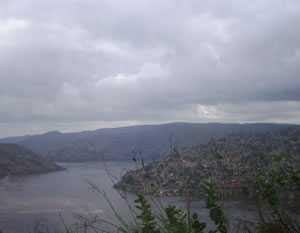It begins in northwest Zambia as the Chambeshi River, and flows northward and then westward for 4,700km (2,900mi).
The Congo's drainage basin covers 3,457,000sq.km (1,335,000sq.mi), five times the size of the state of Texas. Much of it is in Zaire, in a vast depression surrounded by mountains and plateaus, from the Rift Valley escarpment in the east to the Cristal Mountains in the west, and from Angola's Lunda Plateau in the south to the Central African Republic's Ubangi Plateau in the north.
 The Congo discharges 43,300 cubic meters (1,460,000 cubic feet) of water into the Atlantic Ocean each second. The only river on Earth with a greater rate of discharge is the Amazon.
The Congo discharges 43,300 cubic meters (1,460,000 cubic feet) of water into the Atlantic Ocean each second. The only river on Earth with a greater rate of discharge is the Amazon.
European Exploration of the Congo
Portuguese explorers discovered the mouth of the Congo in the 15th century, but only 208km (130mi) of its lower course were navigable owing to the daunting presence of the Cauldron of Hell, a gorge of cascading, impassable rapids.
Anglo-American explorer Henry Stanley (1841-1904) became the first white man to navigate the middle reaches of the Congo after he cut across country from east Africa in 1877-78.
Nineteenth-century travelers referred to the green centre of Africa as the Dark Continent. They thought it was impenetrable jungle, full of bloodthirsty cannibals and ferocious beasts.
Rain Forest of the Congo Basin
The equatorial rain forest of the CongoRiver basin represents roughly a tenth of the world's rain forests.
When viewed from above, this primeval forest resembles an inland sea of rolling green vegetation. In the dense canopy of the forest, some 30m (100ft) above the ground, a rich variety of tree species competes for direct sunlight and heat. Of these, a few manage to outgrow the rest into an emergent layer, opening their entire crowns above the forest
Lianas are quick to take advantage of emergent trees, and woodpeckers make forays for insects amid their branches.
Orchids, ferns and bromeliads that root themselves to the trunks and branches of the trees grow in the canopy. Red colobus and mustached monkeys, chimpanzees and mandrills also live here. Birds, such as the blue fairy flycatcher, the African grey parrot and the yellow-casqued hornbill, and butterflies, such as the African giant swallowtail and the skipper also reside in the canopy.
Beneath the canopy, other trees stretch upward in search of the scant sunlight filtering through. Here live pythons and vipers; birds, such as the touraco and bee-eater; the epauletted fruit bat and the striped squirrel. In the humid, twilight zone of the forest floor herbivores, including the banded duiker, the bongo and the water chevrotain, graze in natural clearings on leaves and grass.
Gorillas feed on buds, berries and stalks, and sleep at night in nests of leaves and twigs.
On the ground, termites construct air-conditioned mounds while goliath and wood-boring beetles scavenge for food in the thin soil around the trunks of tall trees.